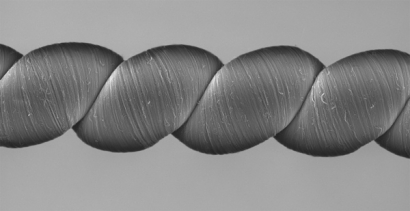
The researchers describe “twistron” yarns and their possible applications in the August 25 issue of Science. These applications include harvesting energy from ocean waves, acting as self-powered breathing monitors when sewn into clothing, harvesting thermal energy from the environment or powering sensors and sensor communications.
“The easiest way to think of twistron harvesters is, you have a piece of yarn, you stretch it, and out comes electricity,” said Dr. Carter Haines BS’11, PhD’15, associate research professor in the Alan G. MacDiarmid NanoTech Institute at UT Dallas and co-lead author of the article. The article also includes researchers from South Korea, Virginia Tech, Wright-Patterson Air Force Base and China.
The material is based on carbon nanotubes, hollow cylinders of carbon 10,000 times smaller in diameter than a human hair. The researchers spun the nanotubes into lightweight yarns, then twisted the yarns into a tight coil.
According to a report on the University of Texas website, in order to generate electricity, the yarns must be either submerged in or coated with an ionically conducting material, or electrolyte, which can be as simple as a mixture of ordinary table salt and water.
“Fundamentally, these yarns are supercapacitors,” said Dr. Na Li, a research scientist at the NanoTech Institute and co-lead author of the study. “In a normal capacitor, you use energy — like from a battery — to add charges to the capacitor. But in our case, when you insert the carbon nanotube yarn into an electrolyte bath, the yarns are charged by the electrolyte itself. No external battery, or voltage, is needed.”
Stretching the coiled twistron yarns 30 times a second generated 250 watts per kilogram of peak electrical power when normalized to the harvester’s weight, said Dr. Ray Baughman, director of the NanoTech Institute and a corresponding author of the study.
“Although numerous alternative harvesters have been investigated for many decades, no other reported harvester provides such high electrical power or energy output per cycle as ours for stretching rates between a few cycles per second and 600 cycles per second.
“At present these harvesters are most suitable for powering sensors and sensor communications. Based on demonstrated average power output, just 31 milligrams of carbon nanotube yarn harvester could provide the electrical energy needed to transmit a 2-kilobyte packet of data over a 100-meter radius every 10 seconds for the Internet of Things.”
The researchers have filed a patent on the technology.
For information: University of Texas, Dallas
Photo: Coiled carbon nanotube yarns, created at The University of Texas at Dallas and imaged here with a scanning electron microscope, generate electrical energy when stretched or twisted. (UTDallas)

